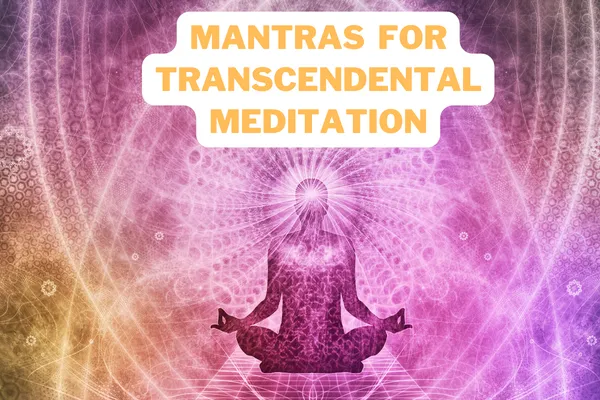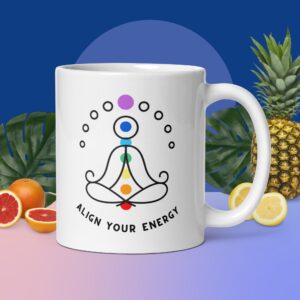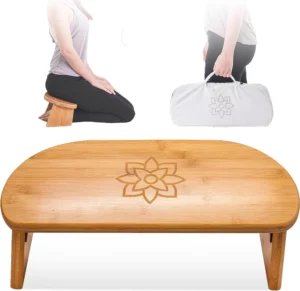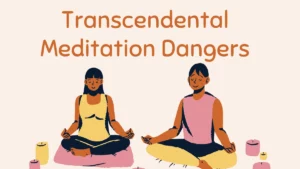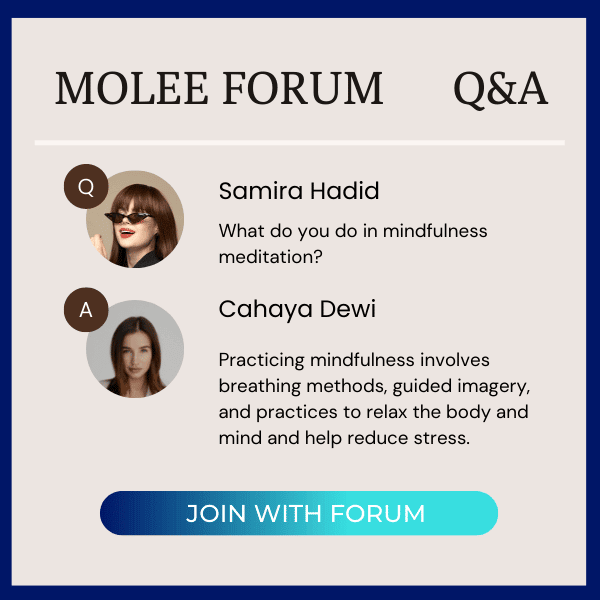Table of Contents
- What are the transcendental meditation mantras?
- The list of Transcendental Meditation Mantras
- How do I choose a mantra for Transcendental Meditation (TM)?
- How to use mantras for transcendental meditation?
- How to meditate with the transcendental meditation technique?
- The Eyes-Opening Benefits of Transcendental Meditation
- The Best List of Popular Meditation Mantras for Other Meditation Techniques
- Lord Shiva Statue in Padmasana Lotus Pose
- Lord Krishna Statue for Home Temple
- Lord Ganapathi Statue for Home Temple
- How can I practice TM at home?
- FAQs on List of Transcendental Meditation Mantras(TM)
- Final Thoughts
Are you looking for some inspiration to help you get started with transcendental meditation? Here is a list of mantras for transcendental meditation to get you started. These mantras will help to focus your mind and guide you in your practice.
Choose one or several that resonate with you and recite them daily to achieve the most benefits from your practice.
What are the transcendental meditation mantras?
Transcendental Meditation mantras are special sounds used in this silent meditation technique to quieten the mind. Selected for their sound value, not meaning, these mantras aid in achieving deep relaxation and awareness. Transcendental meditation mantras belong to the family of Sanskrit mantras.
Each practitioner gets their unique recommended mantra from a certified TM teacher, enhancing their meditation journey.
The list of Transcendental Meditation Mantras
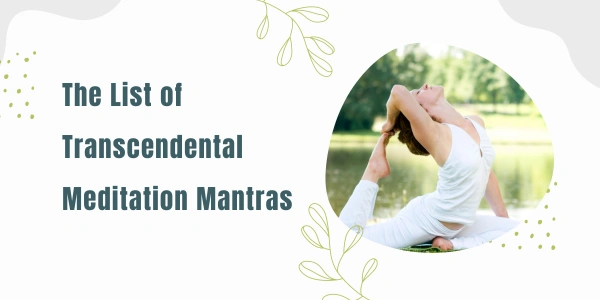
Ever heard about Transcendental Meditation mantras?
These are unique sounds, which when repeated during meditation, help quiet your mind and foster deep relaxation. They’re kind of special because they lack a specific meaning, so your mind doesn’t get caught up in thoughts.
In TM, you get your personal mantra from a certified teacher, a kind of secret tool, picked just for you. Intrigued?
Remember, it’s crucial to learn TM from a certified teacher to ensure it’s done safely and effectively. Ready to explore?
TM could be a great new step in your meditation journey!
What are the 16 TM Mantras?
Here is the list of the most popular TM mantras used in meditation. Read our article to unveil the hidden meanings of these mantras.
Transcendental Meditation Mantras List
- eng
- em
- enga
- ema
- ieng
- iem
- ienga
- iema
- shirim
- shiring
- kirim
- kiring
- hirim
- hiring
- sham
- shama
List of Transcendental Meditation Mantras Sounds by Age
The transcendental meditation mantra can be used by people of all ages and requires no special equipment or training. The only thing needed is a quiet place to sit or recline in comfortable clothing. The transcendental meditation mantra can be learned from a qualified teacher or by attending a retreat center.
At what age should you start using transcendental meditation mantra sounds?
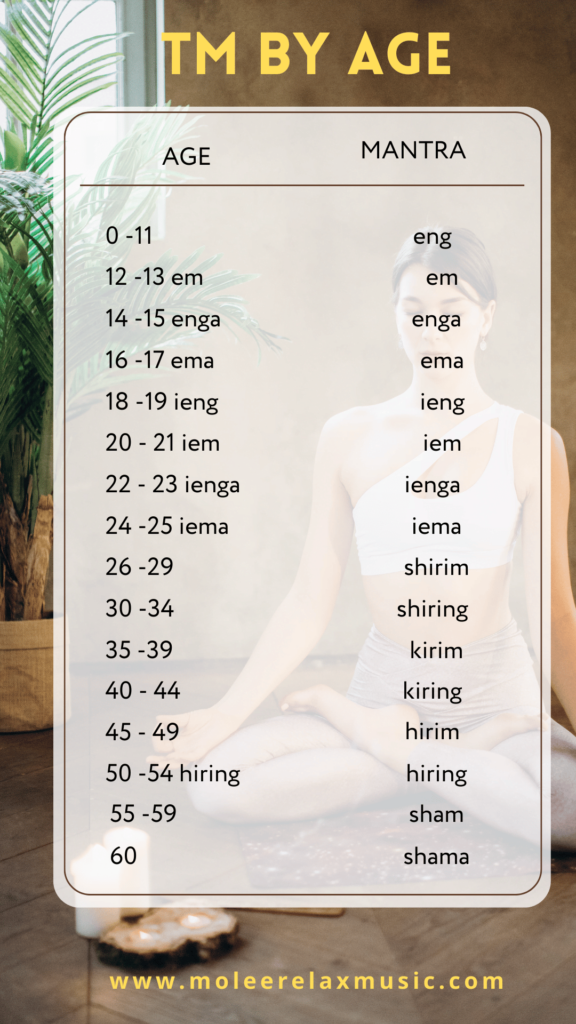
The answer may surprise you. While there are many people who believe that transcendental meditation is only for those who are older, the truth is that it can be beneficial for people of all ages.
List of Transcendental Meditation Mantras Sounds by Gender
When it comes to choosing a mantra sound for Transcendental Meditation, there are different schools of thought. Some people believe that the sound should be chosen based on its meaning, while others believe that the sound itself is not as important as the intention behind it. There is also a school of thought that suggests that the sound should be chosen based on gender.
The reasoning behind this last suggestion is that certain sounds resonate more deeply with either masculine or feminine energy. For example, the sound “om” is often associated with the divine feminine, while the sound “ah” is associated with the divine masculine. Therefore, choosing a mantra sound based on gender can help to create more balanced energy within the individual.
Of course, it is ultimately up to the individual to choose which mantra sounds and feels right for them. There is no one correct answer when it comes to Transcendental Meditation. However, taking into account all of the different factors involved can help to make the decision-making process a little bit easier.
List of Transcendental Meditation Mantras for Males and Females
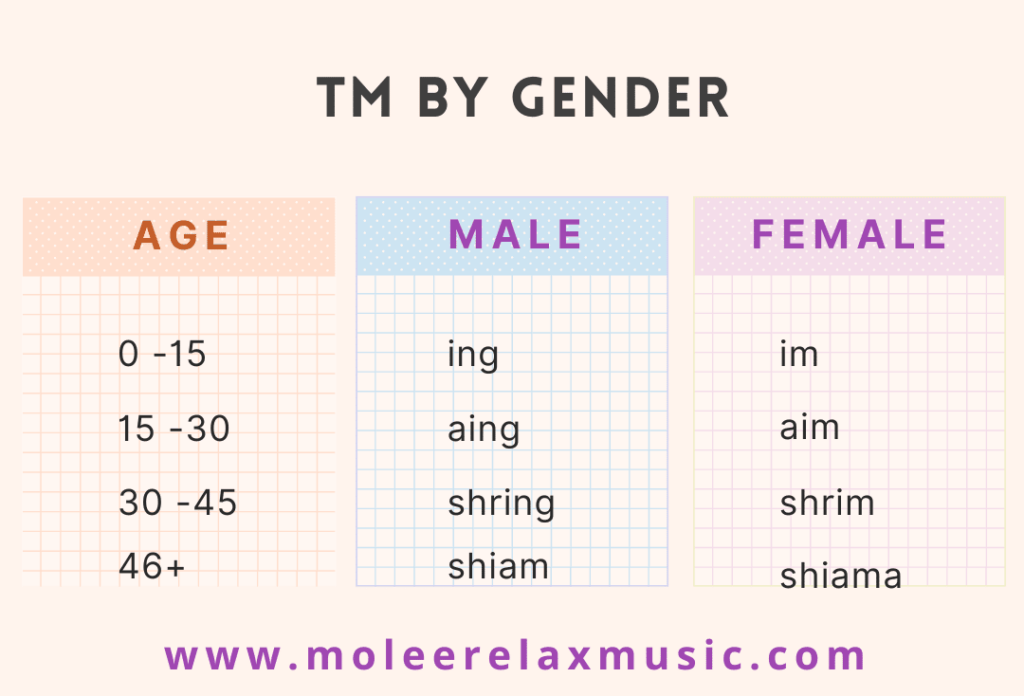
How do I choose a mantra for Transcendental Meditation (TM)?
When it comes to Transcendental Meditation (TM), the selection of a mantra isn’t a DIY process. Instead, it’s a crucial part of the training and it’s done by a certified TM teacher. In a private ceremony, the teacher carefully assigns a unique mantra to each student based on a range of factors.
In Transcendental Meditation, a unique mantra is assigned to each practitioner by a certified TM teacher. It’s not something you choose yourself, ensuring it’s best suited for your individual meditation journey.
These factors aren’t publicly disclosed but are part of the traditional knowledge inherited from Maharishi Mahesh Yogi, the founder of TM. The mantra isn’t just a random word, but a specific sound vibration that is intended to facilitate deep relaxation and transcendental experiences for the practitioner.
It’s important to note that learning the correct technique and getting your own unique mantra from a certified TM teacher is vital for effective practice.
The difference between meditation and transcendental mantras?
Meditation is a mental and physical discipline that includes the practice of mindfulness, which is the intentional focusing of one’s attention on the present moment. TM mantras are words or sounds that are repeated during meditation in order to focus the mind and achieve a state of inner peace. Both meditation and transcendental mantras can be used to promote relaxation, increase self-awareness, and reduce stress.
However, there are some key differences between these two practices. Meditation is typically done with the eyes closed and focused on the breath, whereas transcendental mantras are usually chanted aloud or repeated silently. Additionally, meditation is often used as a tool for exploring the subconscious mind, whereas transcendental mantras are typically used as a way to achieve a state of deep relaxation.
Ultimately, both mediation and transcendental mantras can be useful in promoting well-being. It simply depends on what type of experience you’re looking for.
What benefits of using the transcendental meditation mantra?
A transcendental meditation mantra is a tool that can be used to help focus the mind and achieve a state of relaxation. The benefits of using the transcendental meditation mantra include reducing stress, improving sleep quality, balanced mental health, and increasing focus and concentration.
How to use mantras for transcendental meditation?
Transcendental meditation mantras are mystical words or phrases that are repeated during meditation in order to create a state of inner peace. While the practice of transcendental meditation is said to date back centuries, it gained popularity in the West in the 1960s thanks to Maharishi Mahesh Yogi, who introduced the technique to celebrities like The Beatles.
These days, anyone can learn how to meditate using a mantra, and there are many resources available to help you get started.
Read our full article on the best meditation benches reviewed by experts to comfort your meditation journey.
How to meditate with the transcendental meditation technique?
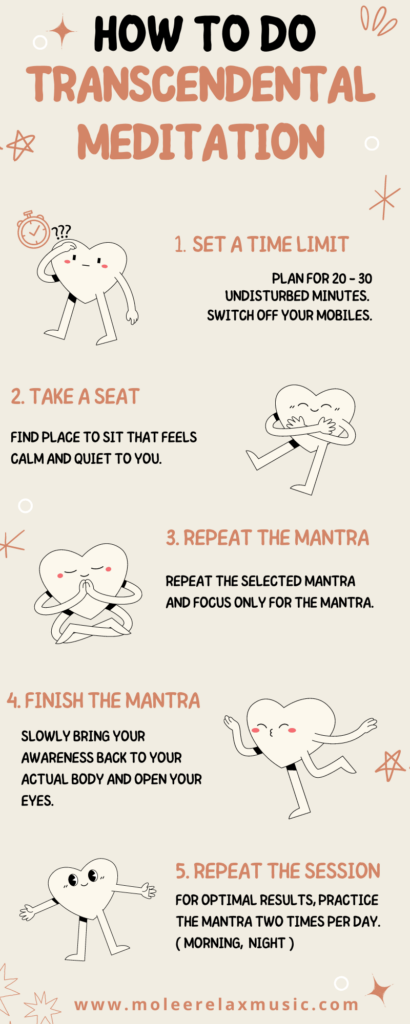
Learn how to do transcendental meditation step by step with infographics.
The Eyes-Opening Benefits of Transcendental Meditation
- Mitigates the impact of stress on the mind and body.
- Enhancement of mental clarity and focus.
- Leading to improved cognitive abilities, better decision-making, and increased productivity in various aspects of life.
- Promotes a more balanced emotional state, and instills a greater sense of inner peace.
- Increasing understanding of oneself fosters personal growth, self-acceptance
- Provides the ability to make conscious choices aligned with one’s true values and aspirations.
Would you like to explore the amazing benefits of transcendental meditation? Read our full article on the benefits of transcendental meditation
The Best List of Popular Meditation Mantras for Other Meditation Techniques
1. Aum or the Om
Aum or the Om is a sacred sound and a spiritual icon in Hindu dharma. It is also a mantra in Hinduism, Buddhism, Jainism, and Sikhism. Aum is of paramount importance in these religions. The syllable is often found at the beginning and the end of chapters in scriptures, as well as in invocations.
Aum is considered a holy symbol as well as a deed done for the betterment of humanity. It is said to be the first word uttered by Brahma after he created the universe. The sound of Aum is used to represent the immeasurable spirit or absolute reality present within all beings.
2. Om Namah Shivaya
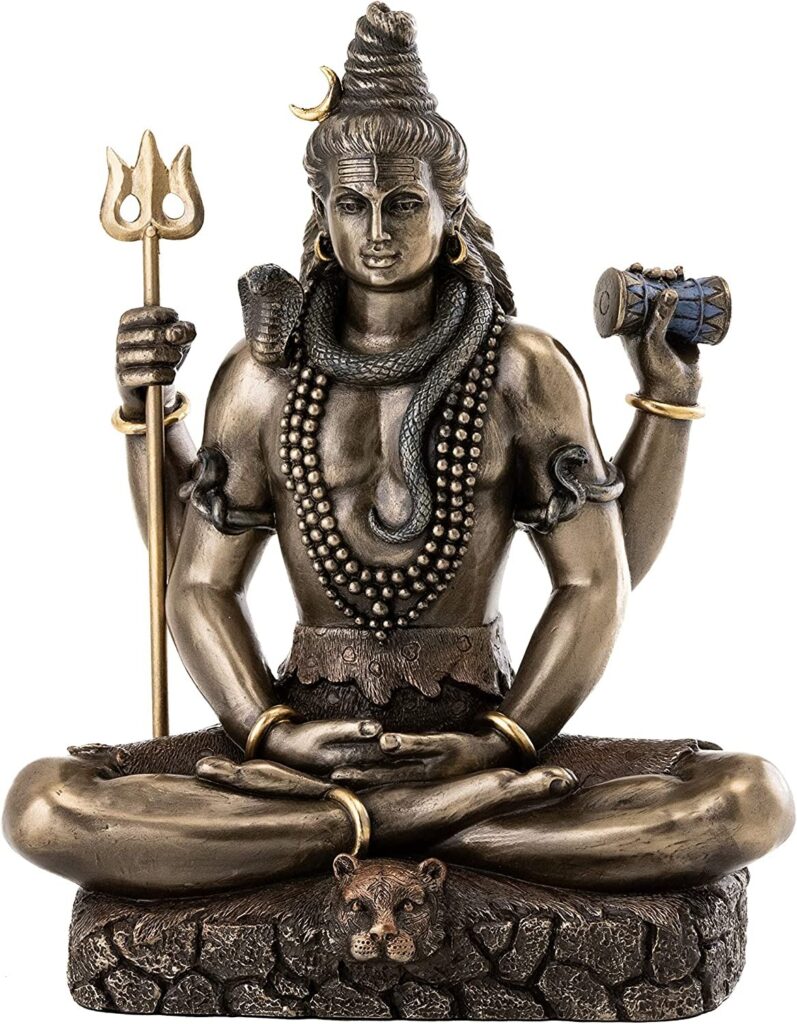
Lord Shiva Statue in Padmasana Lotus Pose
- Premium sculpted cold-cast resin.
- Real bronze powder mixed with resin.
- Measures 8.75 inches tall, 3 inches wide, and 5.5 inches long.
- Perfect size to display on an altar or desk.
Om Namah Shivaya is a very popular Hindu mantra that is used as a form of worship. The literal translation of the mantra is “I bow to Lord Shiva.” It is often chanted during puja, or worship ceremonies, and is also used as a form of meditation. The mantra is believed to bring peace and happiness and to help purify the mind and body.
There are many different interpretations of the mantra, but all agree that it is a powerful way to connect with Lord Shiva. By chanting Om Namah Shivaya, we can show our devotion to Lord Shiva and ask for his blessings.
3. Hare Krishna
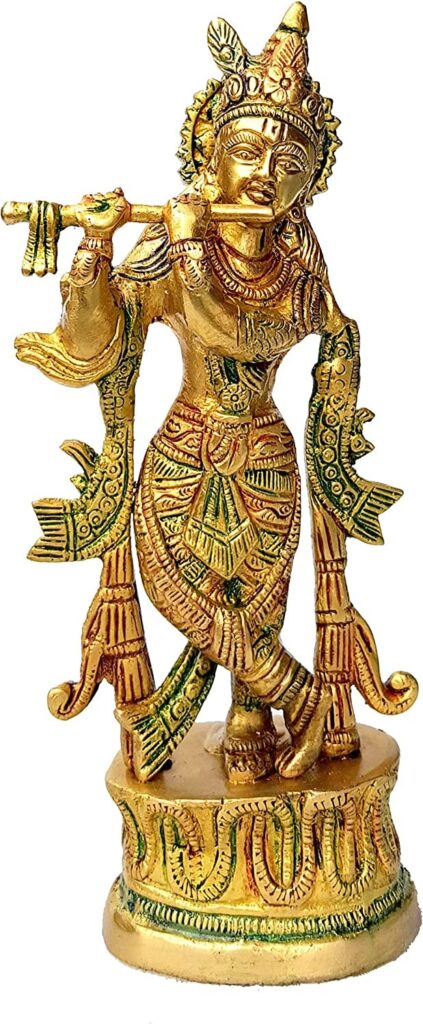
Lord Krishna Statue for Home Temple
- Made of 100% solid Brass for your Home
- Statue for Spirituality, Peace, Harmony, Good Luck, and Wellness.
- Dimensions: Length – 10.5 cm Width- 5 cm Height – 22.5 cm Weight: 1.1 Kg
Hare Krishna is a religious sect that was founded in the city of Vrindavan in the year 1486. The sect is based on the teachings of the ancient Hindu scriptures, and its followers worship the God Krishna. Hare Krishnas are known for their use of chanting and pilgrimage, and they often dress in traditional Indian clothing.
The sect has many famous temples and shrines, and its members typically live in communal houses known as ashrams. Hare Krishnas believe that by chanting the names of Krishna and meditating on his image, they can achieve salvation. The sect has been criticized by some for its strict rules and unusual practices, but its members continue to maintain a strong community worldwide.
4. I am that I am
I am That I am is a form of transcendental meditation that allows practitioners to connect with the divine within themselves. This connection can be experienced as a profound sense of peace and well-being, as well as a deeper understanding of the universe and one’s place within it.
I am That I am is not about acquiring new knowledge or beliefs, but rather about rediscovering the truth that lies within all of us. By meditating on this truth, we can access our own inner wisdom and guidance, which can lead us to a more fulfilling and purposeful life. Ultimately, I am That I Am is about accessing the divinity within ourselves so that we can live in harmony with all of creation.
5. Aham Prema
Aham Prema is the Sanskrit term for “I am Love.” This declaration is a powerful statement of self-acceptance and self-love. When we say “Aham Prema,” we are acknowledging that we are worthy of love and that we are capable of giving and receiving love.
This affirmation can be used as a tool to heal old wounds and cultivate more self-love. By repeating this mantra, we can begin to see ourselves through the lens of love, and our lives will begin to reflect this change. We will attract more love into our lives, and we will be better able to give love unconditionally.
6. Ho’oponopono
Ho’oponopono is an ancient Hawaiian practice of reconciliation and forgiveness. Traditionally, it was used to resolve conflicts within families and communities. Today, it is often practiced as a form of self-care, a way to let go of past hurts and pain.
The practice involves four steps: saying sorry, asking for forgiveness, making amends, and Blessings/Aloha. In doing Ho’oponopono, we take responsibility for our own feelings and hurt, rather than trying to place blame on others.
As we let go of the past, we open ourselves up to healing and reconciliation. By practicing Ho’oponopono, we can find peace within ourselves and in our relationships with others.
7. Om Mani Padme Hum
The Om Mani Padme Hum is a Buddhist mantra that is widely used in meditation. The mantra itself is composed of six syllables, which represent the six perfections of the Buddha: generosity, morality, patience, diligence, concentration, and wisdom.
The mantra is believed to provide guidance on the path to enlightenment and can be used as a tool for reaching deeper levels of meditation. In addition, the mantra is often chanted as a way of invoking the blessings of the Buddha. For many Buddhists, the Om Mani Padme Hum is a deeply meaningful and powerful statement of faith.
8. Lumen de Lumine
The Lumen de Lumine mantra is a prayer for guidance and protection. It is said to help illuminate the path ahead, as well as provide strength and courage in times of difficulty. The mantra can be recited at any time but is particularly powerful when chanted during meditation or prayer.
The words of the mantra are simple, but their meaning is deeply profound. By repeating the mantra, we open ourselves up to guidance from the light of truth. In doing so, we become more capable of discerning right from wrong and making choices that lead to a life of peace and happiness.
The Lumen de Lumine mantra is a reminder that we are never alone; even in the darkest of times, we can find our way back to the light.
9. Om Gam Ganapataye Namaha
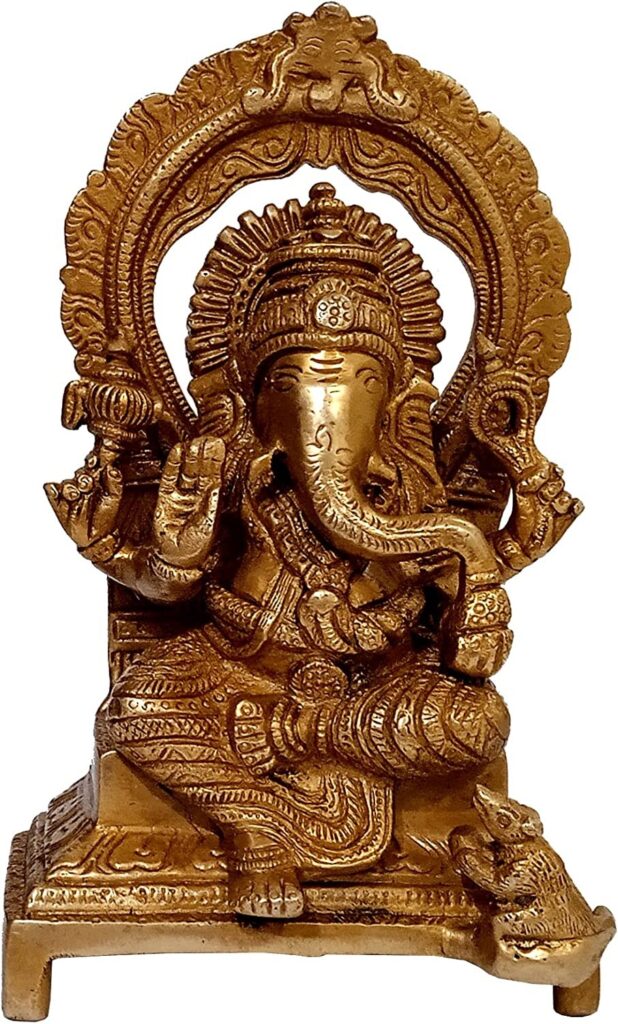
Lord Ganapathi Statue for Home Temple
- Collectible Ganesha idol in classic mandapam design.
- Made from pure solid brass metal
- Dimensions: 4 * 3 * 9 inches (Length * Width * Height) | Weight: 1.6 kilograms
Om Gam Ganapataye Namaha is a mantra that is traditionally used for invoking the energy of Lord Ganesha. The mantra can be chanted at any time, but it is particularly powerful when recited before embarking on a new venture or undertaking.
The words of the mantra invoke the energy of Lord Ganesha, who is the patron deity of beginnings. He is known for his ability to remove obstacles and pave the way for success. As such, chanting Om Gam Ganapataye Namaha can help to clear away any obstacles that may be standing in your way.
It is a powerful tool for anyone who desires to create positive change in their life. Chant it with intention and see what doors begin to open for you.
Read our full article on Ganesha Mantra for a detailed insight into how these mantras help to discover your success and wisdom.
10. Sat Nam
Sat Nam means “Truth is my identity.” It is a sacred mantra used in Kundalini Yoga and Sikhism. The word “Sat” means truth, reality, or essence of Being. “Nam” means identity, name, or destiny. So the meaning of Sat Nam is that truth is our essential nature.
When we live in alignment with our truth, we are living in our highest state of Being. The Sat Nam mantra is used as a tool to help us connect with our true nature and live in alignment with our highest selves. The practice of chanting Sat Nam can help to quiet the mind, bring us into the present moment, and connect us with our deepest truth.
By aligning with our Sat Nam, we are able to live more fully in accordance with our highest purpose.
How can I practice TM at home?
TM can be practiced anywhere, but it is important to find a comfortable place to sit or recline. For best results, practitioners should meditate at the same time each day and maintain a regular practice schedule.
To create a meditative atmosphere when you choose to practice transcendental meditation at home, you can also design custom neon signs. Close your eyes and relax under this soft light.

TM at home to let fatigue disappear and find inner peace and tranquility. Let the colors of neon signs bring the soul into endless tranquility and beauty.
Enjoy this unique TM experience and let your soul be purified and sublimated under the neon signs.
FAQs on List of Transcendental Meditation Mantras(TM)
1. Can you choose your own TM mantra?
When you hear the word “mantra,” you might think of a religious chant or a phrase that is repeated for meditation purposes. However, a mantra can simply be a word or phrase that you use to focus your attention. You might choose a mantra that is inspirational or that helps to keep you motivated. For example, your mantra might be “I can do this” or “I am strong.”
2. What is a good one-word mantra?
For some people, a simple word like “peace”, “love”, “unity” or “abundance” can be a good single-word mantra. Others may prefer a more specific phrase, such as “I am strong” or “I can do this.”
3. Is transcendental meditation effective?
Research on the efficacy of transcendental meditation (TM) is mixed, with some studies showing positive effects and others showing no significant difference between TM and other relaxation techniques. A 2006 systematic review of research concluded that TM could be helpful for reducing stress and anxiety, improving cardiovascular health, and managing pain.
4. Is transcendental meditation Hindu?
Transcendental meditation, also known as TM, is a type of meditation that was popularized in the West by Maharishi Mahesh Yogi. Maharishi was born in India and originally trained as a Hindu priest, but he later developed his own form of meditation that could be practiced by people of any religion. While TM does have some roots in Hinduism, it is not exclusively a Hindu practice.
5. Can transcendental meditation be self-taught?
TM can be learned easily by following directions in a book or audiobook, or through an online course. However, it’s important to find a qualified teacher if possible, as they can answer any questions and help ensure that you’re practicing correctly.
Final Thoughts
If you are looking to try transcendental meditation, or are just curious about what the practice entails, we have included a list of mantras for transcendental meditation in our article. These simple phrases can help you get started on your journey to inner peace.


